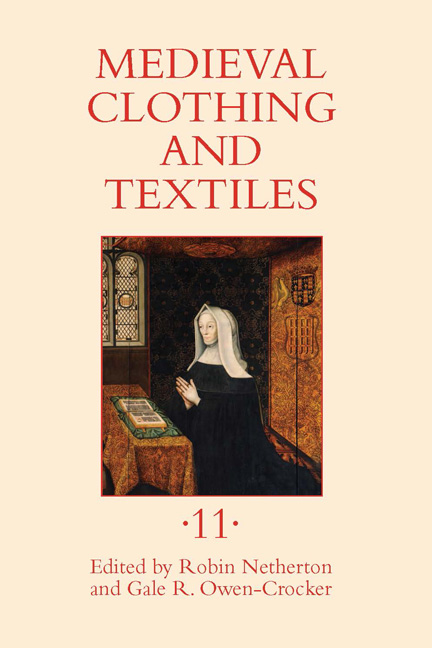Book contents
- Frontmatter
- Contents
- Illustrations
- Tables
- Contributors
- Preface
- 1 Production, Quality, and Social Status in Viking Age Dress: Three Cases from Western Norway
- 2 The Effect of Spindle Whorl Design on Wool Thread Production: A Practical Experiment Based on Examples from Eighth-Century Denmark
- 3 The Shirt Attributed to St. Louis
- 4 Angevin-Sicilian Sumptuary Statutes of the 1290s: Fashion in the Thirteenth-Century Mediterranean
- 5 The Devil on My Tail: Clothing and Visual Culture in the Camposanto Last Judgment
- 6 “Transposing þe shapus þat God first mad them of”: Manipulated Masculinity in the Galaunt Tradition
- 7 Textiles and Dress in the Household Papers of Lady Margaret Beaufort (1443–1509), Mother of King Henry VII
- 8 “Like two artificial gods”: Needlework and Female Bonding in A Midsummer Night's Dream
- Recent Books of Interest
- Contents of Previous Volumes
5 - The Devil on My Tail: Clothing and Visual Culture in the Camposanto Last Judgment
Published online by Cambridge University Press: 05 December 2015
- Frontmatter
- Contents
- Illustrations
- Tables
- Contributors
- Preface
- 1 Production, Quality, and Social Status in Viking Age Dress: Three Cases from Western Norway
- 2 The Effect of Spindle Whorl Design on Wool Thread Production: A Practical Experiment Based on Examples from Eighth-Century Denmark
- 3 The Shirt Attributed to St. Louis
- 4 Angevin-Sicilian Sumptuary Statutes of the 1290s: Fashion in the Thirteenth-Century Mediterranean
- 5 The Devil on My Tail: Clothing and Visual Culture in the Camposanto Last Judgment
- 6 “Transposing þe shapus þat God first mad them of”: Manipulated Masculinity in the Galaunt Tradition
- 7 Textiles and Dress in the Household Papers of Lady Margaret Beaufort (1443–1509), Mother of King Henry VII
- 8 “Like two artificial gods”: Needlework and Female Bonding in A Midsummer Night's Dream
- Recent Books of Interest
- Contents of Previous Volumes
Summary
At the bottom right of the Last Judgment in the Camposanto in Pisa (figs. 5.1 and 5.2), probably painted in the 1330s, a richly dressed woman clings desperately to another woman standing next to her (figs. 5.3 and 5.4). She is being dragged inexorably towards hell by the blackened and disembodied hands of a devil who grabs at the clothing of his victim. The frescoes were badly damaged when the Camposanto was bombed in 1944. However, it is possible to study the depiction of the doomed woman thanks to painstaking restoration work on the frescoes, the sinopie (under paintings) separated from the top layer of the frescoes as part of the postwar restoration, and Carlo Lasinio's early-nineteeth-century engravings.
The woman wears an overdress which splits below the bust to reveal the matching stripes of her gonnella. One of the devils reaches out from the adjacent fresco of the Inferno to take a firm hold of the upper part of the train of the woman's split overdress, the bottom of which clearly lies on the ground disappearing behind the rocky outcrop of hell. It is unclear whether the woman's companion, to whom she clings so tightly, is trying to help or to rid herself of someone whose fate she does not wish to share. The woman physically pulled into hell must have spoken eloquently to a contemporary audience. Placed near the bottom of the fresco, she is clearly visible, her distress easily discernible through her gesture and facial expression. This article will focus on the doomed woman, trapped and consigned to perpetual suffering by the train of her dress, as the starting point for an exploration of the potential impact of this visual motif.
It is challenging for a modern viewer to approach the Camposanto frescoes with a “period eye,” taking into account the contextual information that could have been brought to them by a contemporary. Some references are clear.
- Type
- Chapter
- Information
- Medieval Clothing and Textiles 11 , pp. 99 - 118Publisher: Boydell & BrewerPrint publication year: 2015



